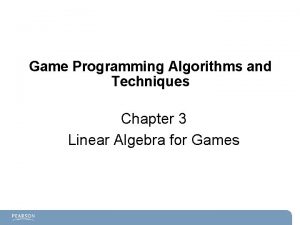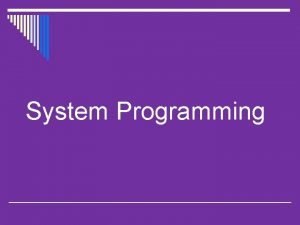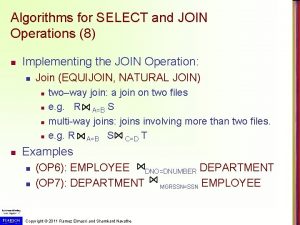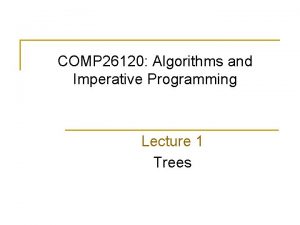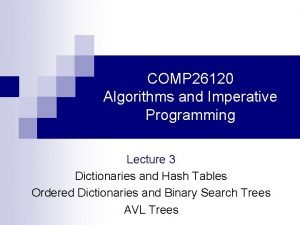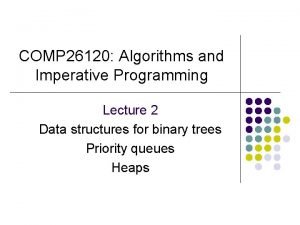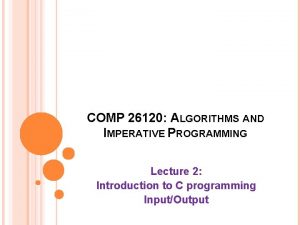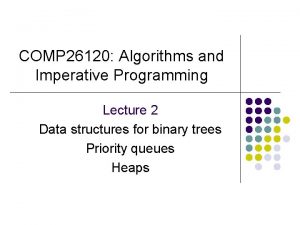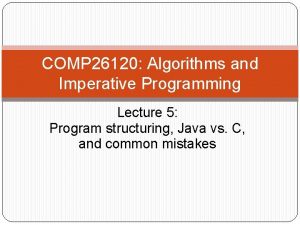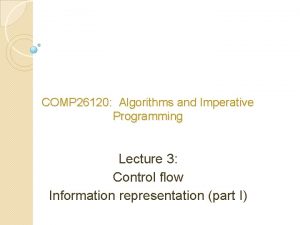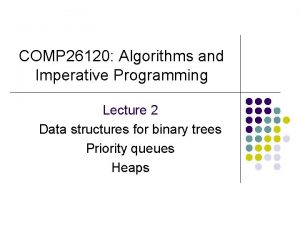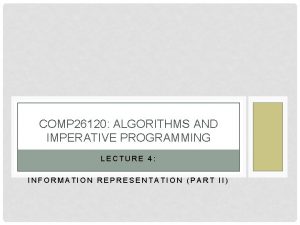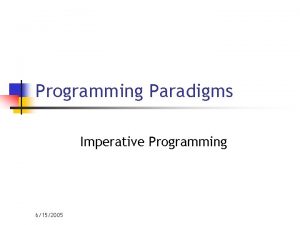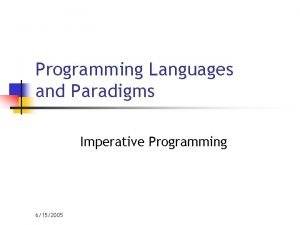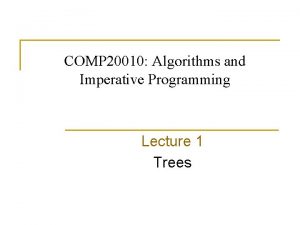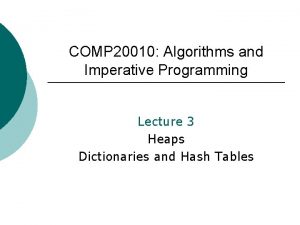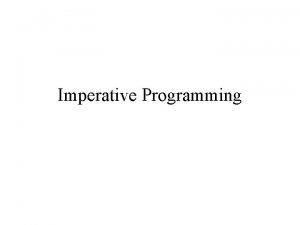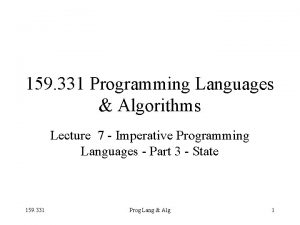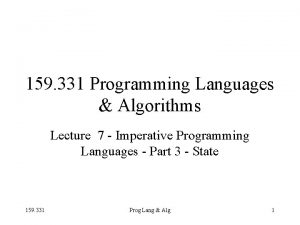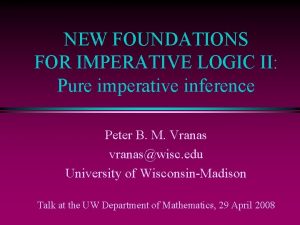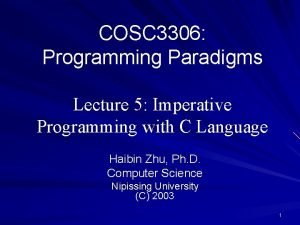COMP 26120 ALGORITHMS AND IMPERATIVE PROGRAMMING LECTURE 4




![INFORMATION REPRESENTATION ARRAYS • Example: a[1] = 10*a[2]; if(a[3]==0 && a[4]) a[4]=a[4]+x; • It INFORMATION REPRESENTATION ARRAYS • Example: a[1] = 10*a[2]; if(a[3]==0 && a[4]) a[4]=a[4]+x; • It](https://slidetodoc.com/presentation_image_h2/7653a993beef0aa8cc971d9bb16671fc/image-5.jpg)


![INFORMATION REPRESENTATION ARRAYS AND POINTERS • Example (cont. ): int a[10]; int *ptr_a; ptr_a=a; INFORMATION REPRESENTATION ARRAYS AND POINTERS • Example (cont. ): int a[10]; int *ptr_a; ptr_a=a;](https://slidetodoc.com/presentation_image_h2/7653a993beef0aa8cc971d9bb16671fc/image-8.jpg)

![INFORMATION REPRESENTATION ARRAYS AND POINTERS • Example: int a[10]; *(a+2)=5; • What is the INFORMATION REPRESENTATION ARRAYS AND POINTERS • Example: int a[10]; *(a+2)=5; • What is the](https://slidetodoc.com/presentation_image_h2/7653a993beef0aa8cc971d9bb16671fc/image-10.jpg)















- Slides: 25

COMP 26120: ALGORITHMS AND IMPERATIVE PROGRAMMING LECTURE 4: INFORMATION REPRESENTATION (PART II)

LECTURE OUTLINE • Information representation (cont. ) • • • Arrays; Arrays and pointers; Multidimensional arrays; Arrays of pointers; Structures; Linked lists;

INFORMATION REPRESENTATION ARRAYS • The basic types are used to build a more complex data. • The simplest example is to group together several variables of a certain data type together and give them the same name. Such data structure is called an array. • An array (a vector), is a collection of elements of the same type. An array has a fixed size. In memory we can allocate in advance the space needed to store an array. • Question: Which commands would you use to allocate the space in memory for an array?

INFORMATION REPRESENTATION ARRAYS • To declare an array, we need to define its type (int, float, char), its name (identifier) and the size of the array. • Example: int a[5]; • Arrays in C are zero-based, i. e. the indices start from 0. In the previous example valid elements are a[0], a[1], a[2], a[3], a[4]. • C does not provide bounds checking, i. e. it does not prevent you from accessing elements beyond the ends of your array, elements that do not actually exist – this may be the source of serious programming errors. • Elements of an array are referenced by their index and can be used as any other variables.
![INFORMATION REPRESENTATION ARRAYS Example a1 10a2 ifa30 a4 a4a4x It INFORMATION REPRESENTATION ARRAYS • Example: a[1] = 10*a[2]; if(a[3]==0 && a[4]) a[4]=a[4]+x; • It](https://slidetodoc.com/presentation_image_h2/7653a993beef0aa8cc971d9bb16671fc/image-5.jpg)
INFORMATION REPRESENTATION ARRAYS • Example: a[1] = 10*a[2]; if(a[3]==0 && a[4]) a[4]=a[4]+x; • It is a good programming practice to define the array size as a constant in a pre-processing command #define. • Example: #define SECOND_YEAR_SIZE 180; int student_ID [SECOND_YEAR_SIZE]; float comp 26120_score [SECOND_YEAR_SIZE];

INFORMATION REPRESENTATION INITIALISATION OF ARRAYS • The array declaration only reserves the space of necessary size in the memory to store the array. However, initially, the values of the array elements are not set. • This can be done at the same time the array is declared, or later in the program. • Example: float comp 26120_score [5]={85. 3, 78. 2, 90. 4, 75. 7, 68. 9}; int student_ID[ ]={5502, 3478, 2234, 2289, 6542}; • Processing the arrays is associated with the loops (for, while);

INFORMATION REPRESENTATION ARRAYS AND POINTERS • Remember, a pointer stores the address of a memory location containing useful data. • An array is a set of consecutive memory locations that store data of certain type. • Each of the array's elements have an address. This allows us to set pointers to point at individual elements in the array. • Example: int a[10]; int *ptr_a; ptr_a=&a[0]; *ptr_a Ox 123 a[0] a[1] a[9] Ox 123. . .
![INFORMATION REPRESENTATION ARRAYS AND POINTERS Example cont int a10 int ptra ptraa INFORMATION REPRESENTATION ARRAYS AND POINTERS • Example (cont. ): int a[10]; int *ptr_a; ptr_a=a;](https://slidetodoc.com/presentation_image_h2/7653a993beef0aa8cc971d9bb16671fc/image-8.jpg)
INFORMATION REPRESENTATION ARRAYS AND POINTERS • Example (cont. ): int a[10]; int *ptr_a; ptr_a=a; • The command ptr_a=a assigns the address of the first element of the array a to ptr_a. • This is correct because the name of the array is equivalent to the memory location of its first element, i. e. (a is the same as &a[0]). This applies to any type of an array.

INFORMATION REPRESENTATION ARRAYS AND POINTERS • There is a relationship between the array indices and pointers. • Example: int a[10]; int *ptr_a; ptr_a=a; *ptr_a=45; ptr_a++; • Explain what is the effect of the last two statements? *ptr_a a[0] a[1] a[9] Ox 124 45 Ox 123 . . . Ox 124
![INFORMATION REPRESENTATION ARRAYS AND POINTERS Example int a10 a25 What is the INFORMATION REPRESENTATION ARRAYS AND POINTERS • Example: int a[10]; *(a+2)=5; • What is the](https://slidetodoc.com/presentation_image_h2/7653a993beef0aa8cc971d9bb16671fc/image-10.jpg)
INFORMATION REPRESENTATION ARRAYS AND POINTERS • Example: int a[10]; *(a+2)=5; • What is the result of the execution of the above statement? • The array name a returns the address to the first element (a is the same as &a[0]). • +2 is the offset, thus we want to access the element a[2]. • *(…) dereferences the address a+2 in order to access its contents. • The same effect can be achieved by a[2]=5. • In the early days using pointer arithmetic instead of the subscripts led to a more efficient and faster code. • This is generally not the case with modern compilers (pointer arithmetic and subscripts tend to be equivalent now). • In many cases using subscripts instead of pointer arithmetic can be preferable from a readability point of view.

INFORMATION REPRESENTATION MULTIDIMENSIONAL ARRAYS • Multidimensional arrays in C are represented as arrays of arrays. • Example: int a[10]; /* one-dimensional array */ float b[3][2]; /*two-dimensional array */ • The elements of multi-dimensional arrays are stored continuously in the memory in a row-wise fashion (the rightmost indices change the fastest). b[0][0] b[0][1] b[1][0] b[1][1] b[2][0] b[2][1] • Pointers can be used as with one-dimensional arrays to access the elements, but the expressions are more intricate. • Write an equivalent pointer-based statement that does b[i][j]=7.

INFORMATION REPRESENTATION ARRAYS OF POINTERS • In C it is possible to define an array of any type (so, an array of pointers is perfectly valid). • Example: int *ptr_a[10]; char *ptr_c[5]; • In some cases multidimensional arrays can be represented as arrays of pointers. • Example: char courses[2][4]; char *ptr_courses[2]; • Homework: Write a C code that would read from the screen the course numbers and initialise the array of pointers. • Homework: Write a C code that implements a simple sorting algorithm (e. g. bubble sort) that will sort the array of strings in ascending order. bytes 2 6 � [0][0] [0][1] [0][2] [0][3] 2 0 8 � [1][0] [1][1] [1][2] bytes 2 6 � 2 0 8 � [1][3] ptr_courses[0] ptr_courses[1]

INFORMATION REPRESENTATION STRUCTURES • User-defined structures are the collections of one or more variables, possibly of different types. • The main application is in organising complicated data where all related variables can be put under one name to form a unit. Think of an example? • To work with a structure we need to: • Define a structure: Structure tags, member variables, structure names and initialisation. • Use a structure: The field operator ". " • Pointers to structures: The "->" operator. • typedef: A facility for creating new names for data types.

INFORMATION REPRESENTATION DEFINING A STRUCTURE • Example: Suppose that we need to register some personal data about a tutor and his tutorial group (e. g. the name, the age, the height, and the home address). char tutor_name[20]; char tutor_address[32]; unsigned int tutor_age; float tutor_height; char student 1_name[20]; char student 1_address[32]; unsigned int student 1_age; float student 1_height; … char student 5_name[20]; … float student 5_height; struct { char name[20]; char address[32]; unsigned int age; float height; } tutor, student[5];

INFORMATION REPRESENTATION STRUCTURE TAGGING • A tag (name) can be associated to each structure definition, which helps when multiple instances of that structure are initialised in the program. • Example: struct person { char name[20]; char address[32]; unsigned int age; float height; }; … struct person tutor; struct person student[5]; struct person second_year[200];

INFORMATION REPRESENTATION STRUCTURE INITIALISATION • Structures are initialised in a similar way as the arrays. • Example: struct person { char name[20]; char address[32]; unsigned int age; float height; }; struct person tutor={“John Stevens”, ” 5 Hazel Drive, Manchester M 20 7 BD”, 36, 182. 0}; • Homework: How would you initialise the array: struct person student[3]=? ? ?

INFORMATION REPRESENTATION ACCESSING THE VARIABLES • Individual variables (fields) in a structure can be accessed using the structure field operator “. ” • Example: struct person { char name[20]; char address[32]; unsigned int age; float height; } tutor={“John Stevens”, ” 5 Hazel Drive, Manchester M 207 BD”, 36, 182. 0}; tutor. age=37; printf(“%6. 1 f”, tutor. height);

INFORMATION REPRESENTATION POINTERS AND STRUCTURES • We already said that pointers can point to anything, so why not pointing to structures? Example: struct person { char name[20]; char address[32]; unsigned int age; float height; } tutor={“John Stevens”, ” 5 Hazel Drive, Manchester M 207 BD”, 36, 182. 0}; struct person *ptr_tutor; ptr_tutor=&tutor; words name address age height ptr_tutor

INFORMATION REPRESENTATION POINTERS AND STRUCTURES • How to access an individual variable in a structure using a pointer (e. g. we want to change tutor’s height in the structure tutor)? • We need to use the “->” operator. ptr_tutor->height=180. 6; • The important thing to notice is that we do not need to dereference the pointer ptr_tutor, as -> operates automatically on the object pointed to by ptr_tutor, i. e. the structure person. • Two or more structures can be nested. • Example: struct person { struct pay_details char name[20]; { char address[32]; long bank_account_number; unsigned int age; float NI_number; float height; float net_pay; struct pay_details salary; }; };

INFORMATION REPRESENTATION STRUCTURE NAMES • We can assign an alias to any simple data type, using the keyword typedef double_precision; typedef long double quad_precision; double_precision a, b; quad_precision c, d; • The same can be done with structures: typedef struct { char name[20]; char address[32]; unsigned int age; float height; } person; person tutor, student[5], second_year[200];

INFORMATION REPRESENTATION LINKED LISTS • C does not provide any dynamic data structures, that can change their structure, size, or reordering the arrangement of its elements. • Such structures are, however, essential in some problems (can you think of an example? ), or make programming much easier and flexible. • One of such structures is a linked list. • It consists of a an array of some useful data (a simple variable, or an object), chained together. For each element in the list we know its predecessor and successor. Also, the first and the last element in the list are uniquely determined. • Linked lists are essential in algorithms involving trees, graphs, hashtables, which you will see in your labs towards the end of this semester and in the second semester, so pay attention.

INFORMATION REPRESENTATION LINKED LISTS • Schematically, we can present a linked list as follows: root data_1 data_2 data_3 … data_n ^ simple (single chained) linked list • Example: Instead of an array struct person student[5], use the definition of a linked list to represent a (potentially variable in size) data structure for a tutorial group. typedef struct person { char name[20]; char address[32]; unsigned int age; float height; struct person *next; } student;

INFORMATION REPRESENTATION LINKED LISTS • Example: Create a linked list consisting of two elements. #include <stdio. h> main() char std_name[20], std_address[32]; unsigned int std_age; float std_height; typedef struct person { char name[20]; char address[32]; unsigned int age; float height; struct person *next; } student; person *root_ptr, *curr_ptr; / * Chain the first element to a root_ptr */ root_ptr=(*student)malloc(sizeof(student)); if (root_ptr == NULL) error_message(); /* Insert the data into the first element */ get_student_data (&std_name, &std_address, &std_age, &std_height); root_ptr->name=&std_name; root_ptr->address=&std_address; root_ptr->age=std_age; root_ptr->height=std_height; curr_ptr=root_ptr; / * Chain the second element to the first * / curr_ptr->next=(*student)malloc(sizeof(student)); if(curr_ptr->next == NULL) error_message(); curr_ptr=curr_ptr->next; /* Insert the data to second element */ get_student_data (&std_name, &std_address, &std_age, &std_height); curr_ptr->name=&std_name; curr_ptr->address=&std_address; curr_ptr->age=std_age; curr_ptr->height=std_height; curr_ptr->next=NULL;

INFORMATION REPRESENTATION LINKED LISTS • Example: Inserting a new element to a linked list. ptr_aux=ptr->next; ptr->next=(*<type>)malloc(sizeof(<type>); ptr=ptr->next; <input the useful data into > ptr->next=ptr_aux; ptr_aux ptr

INFORMATION REPRESENTATION LINKED LISTS • Example: Deleting an element from ptr a linked list. ptr_aux 1=ptr->next; ptr_aux 2=ptr_aux 1 ->next; ptr->next=ptr_aux 2; free(ptr_aux 1); ptr_aux 1 ptr_aux 2
 Analysis of algorithms lecture notes
Analysis of algorithms lecture notes Introduction to algorithms lecture notes
Introduction to algorithms lecture notes Computational thinking algorithms and programming
Computational thinking algorithms and programming Synchronization algorithms and concurrent programming
Synchronization algorithms and concurrent programming Lerp
Lerp 01:640:244 lecture notes - lecture 15: plat, idah, farad
01:640:244 lecture notes - lecture 15: plat, idah, farad Imperative statement in assembly language
Imperative statement in assembly language Imperative programming languages
Imperative programming languages Imperative statement in assembly language
Imperative statement in assembly language Advanced assembler directives in system programming
Advanced assembler directives in system programming C programming lecture
C programming lecture Perbedaan linear programming dan integer programming
Perbedaan linear programming dan integer programming Greedy algorithm vs dynamic programming
Greedy algorithm vs dynamic programming Definition of system programming
Definition of system programming Integer programming vs linear programming
Integer programming vs linear programming Definisi integer
Definisi integer 1001 design
1001 design Professor ajit diwan
Professor ajit diwan Association analysis: basic concepts and algorithms
Association analysis: basic concepts and algorithms Computer arithmetic: algorithms and hardware designs
Computer arithmetic: algorithms and hardware designs Cos 423 princeton
Cos 423 princeton Data structures and algorithms tutorial
Data structures and algorithms tutorial Algorithms for select and join operations
Algorithms for select and join operations Algorithms and flowcharts
Algorithms and flowcharts Undecidable problems and unreasonable time algorithms.
Undecidable problems and unreasonable time algorithms. Information retrieval data structures and algorithms
Information retrieval data structures and algorithms




